Transportation Economics/Introduction
< Transportation Economics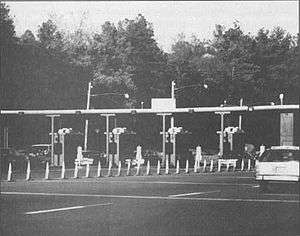
Transportation systems are subject to constraints and face questions of resource allocation. The topics of supply and demand, as well as of equilibrium and disequilibrium, arise and give shape to the use and capability of the transportation system.
What is Transportation Economics?
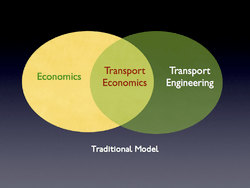
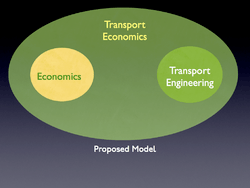
Transport Economics is the study of the movement of people and goods over space and time. It is a branch of economics that deals with the allocation of resources within the transport sector. Historically, it has been thought of as the intersection of microeconomics and civil engineering, as shown on the right.
However, if we think about it, traditional microeconomics is just a special case of transport economics, with fixed space and time, and where the good being moved is money, as illustrated on the right.
Topics traditionally associated with Transport Economics include Privatization, Nationalization, Regulation, Pricing, Economic Stimulus, Financing, Funding, Expenditures, Demand, Production, and Externalities.
Demand Curve
How much would people pay for an "A" in a transportation class?
- How many people would pay $5000 for an A?
- How many people would pay $500 for an A?
- How many people would pay $50 for an A?
- How many people would pay $5 for an A?
If we draw out these numbers, with the price on the Y-axis, and the number of people willing to pay it on the X-axis, we trace out a usually nonlinear demand curve. With the exception of unusually ethical or ridiculous groups, the lower the price, the greater the number of people who are willing to pay. This rule applies to any good or service, such as the price of gasoline, which would get a similar, but not identical, curve.
Demand and Budgets in Transportation
It is often said, "Travel is a derived demand." There would be no travel without the activities being undertaken at the trip ends. Travel is seldom consumed for its own sake, except the occasional "Sunday Drive" or nature walk. On the other hand, there is always a need for people to leave home: a 20-30 minute separation between the home and workplace is common, and 60-90 minutes of travel per day total is common, even for nonworkers. We know that the more expensive something is, the lesser the quantity that will be consumed. For example, if gas prices doubled, there would be less travel. Similarly, the longer it takes to get from A to B, the less likely it is that people will go from A to B.
In short, we are dealing with a downward sloping demand curve, where the curve itself depends not only on the characteristics of the good in question, but also on its complements or substitutes.
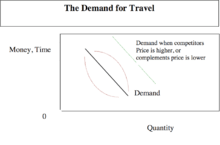
The Shape of Demand
When working with demand, we need to estimate two things. First, the shape of demand (is it linear or curved, convex or concave, what function best describes it). Second, the sensitivity of demand for a particular thing (a mode, an origin destination pair, a link, a time of day) to price and time in the short run and the long run—in other words, its elasticity.
- Are the choices continuous (the number of miles driven) or discrete (car vs. bus)?
- Are we treating demand as an absolute or a probability?
- Does the probability apply to individuals (disaggregate) or the population as a whole (aggregate)?
- What is the trade-off between money and time?
- What are the effects on demand as a function of the time and money costs of competitive or complementary choices (cross elasticity)?
Supply Curve
How much would a person need to pay you to write an "A"-worthy 20 page term paper for a given transportation class?
- How many would write it for $100,000?
- How many would write it for $10,000?
- How many would write it for $1,000?
- How many would write it for $100?
- How many would write it for $10?
If we draw out these numbers for all the potential entrepreneurial people available, we trace out a supply curve. The lower the price, the lesser the number of people who are willing to supply the paper.
Supply and Demand Equilibrium
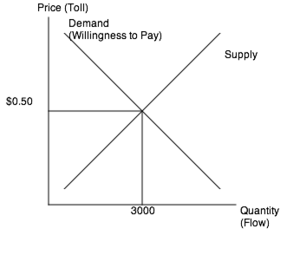
As with earning grades, transportation is not free; it costs both time and money. In transportation economics, costs are represented by a supply curve, which rises with the amount of travel demanded. As described above, demand (for example, the number of vehicles which want to use a facility) depends on the price: the lower the price, the higher the demand. These two curves intersect at a point of equilibrium. In the example figure, they intersect at a toll of $0.50 per km, and flow of 3000 vehicles per hour. Time is usually converted to money to simplify analysis.
Costs may be variable, and can include users' time and out-of-pockets costs. Out-of-pocket costs can be paid on a per trip or per distance basis, for example, tolls and gasoline, or fixed, for example, insurance or buying an automobile, which are only borne once in a while and are independent an individual trip's cost.
Equilibrium in a Negative Feedback System

Supply and Demand comprise the economists' view of transportation systems. They are equilibrium systems. This means a system subject to a negative feedback process:
An increase in A causes a decrease in B. An increase in B causes an increase in A. In math terminology, A is inversely proportional to B, while B is directly proportional to A, thus indirectly causing itself to decrease.
Example: If A is Traffic Congestion and B is Traffic Demand, then increased congestion reduces demand, but increased demand increases congestion.
Disequilibrium
Many elements of the transportation system, however, do not necessarily result in equilibrium. Take the case where an increase in A causes an increase in B. An increase in B causes an increase in A. An example where an increase in A, Traffic Demand, causes an increase in B, Gas Tax Revenue, which causes an increase in Road Building, which in turn causes an increase in traffic demand. This example assumes that the gas tax generates more demand from the resultant road building than it costs in sensitivity to demand and the price, in other words, that the investment is worthwhile. This is dubbed a positive feedback system, and in some contexts a "Virtuous Circle", where the "virtue" is the value judgment (though this "virtue" may not necessarily be positive).
Similarly, there is an opposing "Vicious Circle", where a decrease in A causes a decrease in B, and a decrease in B causes a decrease in A. A classic example of this is where A is Transit Service and B is Transit Demand. Again "vicious" is a value judgment. A decrease in service results causes a decrease in the number of transit riders, and a decrease in transit riders reduces claims on transportation resources, leading to more service cutbacks.
These systems interact, for example, an increase in road building may attract transit riders to cars, while the additional drivers pay gas taxes, which generate more roads.
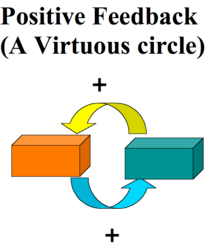
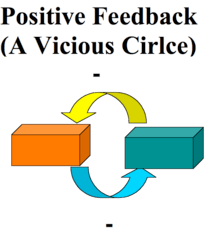
One might ask whether positive feedback systems converge or diverge. The answer is that it depends on the system, and, in particular, when or where the system is observed. There might be some point where, no matter how many additional roads are built, there will be no more traffic demand, as all the drivers already consume the maximum amount of travel that can be attained. We have yet to reach that point for roads, but on the other hand, we have done so for many goods. In most parts of the United States, the price of water probably does not affect how much water used, and a lower price for tap water would not increase the rate of consumption. Substitutes (bottled water, water delivery services, rainwater collection) might be used if their prices were lower, or tap water were costlier. Price would probably affect behaviors such as lawn watering and car washing more than behaviors such as drinking.
Provision
The business of providing transportation services spans both public and private sectors.
- Roads are generally publicly owned in the United States, though the same is not true of highways in other countries. Furthermore, public ownership has not always been the norm; many countries had a long history of privately owned turnpikes, for example, in the United States private roads were common from the beginning of its history through the early 1900s.
- Railroads are generally private.
- Carriers (Airplane, Bus, Truck, and Train Operators) are often private firms.
- Formerly private urban transit operators have been taken over by local government since the 1950s in a process called municipalization. With the rise of the automobile, transit systems steadily lost passengers and money.
The situation is complicated by the idea of contracting or franchising. Often private firms operate "public transit" routes, either under a contract, a fixed price, or an agreement where the private firm collects the revenue on the route (a franchise agreement). Franchises may be subsidized if the route is losing money, or may require bidding if the route is profitable. Private provision of public transportation is common in the United Kingdom.
Principles
Specific principles of highway transportation include:
- Users commit a significant amount of their own time to the consumption of the final good. In other words, they spend time traveling. You can think of it as part of the "cost" of using the service. While the contribution of user time is found in all sectors to some extent, this fact is a dominant feature of highway travel.
- Links are routes of transportation. They are collected into large bundles which comprise a route. Individual links may be only a small share of the bundle. If we begin by assuming each link is "autonomous", then the final consumption bundle includes a large number of imperfect complements.
- Highway networks have very specialized geometries. Competition, in the form of alternative routes between the point of origin and destination, is almost always present. Nevertheless there are large degrees of spatial monopoly; each link occupies a unique space, and spatial location affects the user's contribution, time.
- There are significant congestion effects which occur both with and without pricing.
- Users choose not only a route for a trip, but whether to make that trip in the first place, to change the destination, or to delay travel on the highway network. These choices are determined by user's previous experiences. See reward systems.
- Individual links may serve multiple markets (origin-destination pairs). There are economies achieved by using the same links on routes serving different markets. This is one factor leading to a hierarchy of roads.
- Quantity cannot be controlled in the short term. Once a road is deployed, it is in the network, with its entire capacity available for use. However, roads are difficult to deploy, responses to demand are slow, and for practical purposes, deployment is irrevocable.
Thought questions
- Should the government subsidize public transportation? Why or why not?
- Should the government operate public transportation systems?
- Is building roads a good idea even if it results in more travel demand?
Sample Problem
Key Terms
- Supply
- Demand
- Negative Feedback
- Positive Feedback
- Equilibrium
- Disequilibrium
- Public Sector
- Private Sector